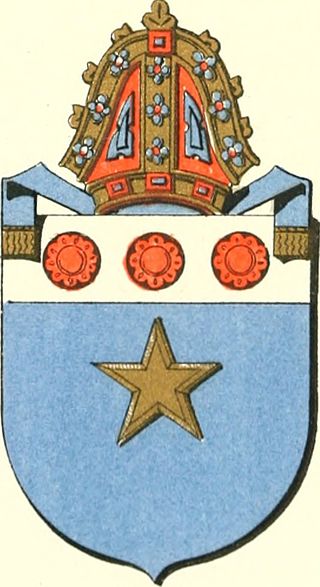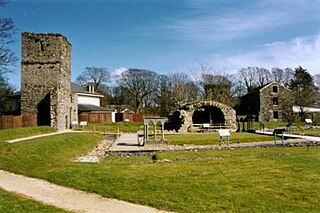Related Research Articles
Thomas de Rossy O. F. M. was a late 14th century Scottish Franciscan friar, papal penitentiary, bishop and theologian. Of unknown, or at least unclear origin, he embarked on a religious career in his early years, entering the Franciscan Order, studying in England and at the University of Paris.
Elisaeus Adougan was a late 14th century and early 15th century Scottish Catholic cleric.
Adam de Lanark, O.P. was a 14th-century Scottish Dominican friar and prelate. Possibly from a Lanark burgess family, he was a Dominican and a priest by 1356, and by 1364 was styled Magister, indicating the completion of a long university education. He first appears in the sources, c. 1355/6 as a confessor of King David II of Scotland; he retained this royal position through the 1350s and into the 1360s; Adam received a number of English safe-conducts to visit King David, who for a time was a prisoner in England.
Simon de Wedale was a 14th-century Augustinian canon who rose to become Abbot of Holyrood and then Bishop of Galloway. Little is known of Simon until he appears on 27 February 1321 as Abbot of Holyrood Abbey near Edinburgh. His accession to this abbacy had only been recent, since either in January of this year or in January 1320, his predecessor Elias, ruling the abbey since at least 1309 and probably earlier, was still abbot. Abbot Simon occurs again in the records on 10 June 1326.
Walter was Chamberlain of Alan, Lord of Galloway and later Bishop of Galloway. As Alan's chamberlain, he succeeded Bishop John after the latter's death, in 1209. His election coincided with the northern expedition of King John of England to secure the submission of King William of Scotland; Alan enjoyed friendly relations with the English king, the latter wishing to make use of Alan's manpower and naval resources, and so the election of Walter may have had something to do with King John.
John of Whithorn was the medieval Bishop of Galloway. His first appearance as bishop-elect is at the coronation of Richard, Cœur de Lion as King of the English at Westminster Abbey on 3 September 1189. He was consecrated at Pipewell Abbey, Northamptonshire, on Sunday 17 September 1189.
Thomas de Kirkcudbright, also known as Thomas de Dalton [de Daltoun], was a medieval prelate from the Kingdom of Scotland. He was apparently a nutritus, or foster son, of Robert V de Brus, Lord of Annandale, and seems to have been closely linked in some way to Adam de Kirkcudbright, the man who held the church of Dalton in Annandale. He was likely a native Galwegian or perhaps a native of Annandale.

Gilbert was a 13th-century Cistercian monk, abbot and bishop. His first appearance in the sources occurs under the year 1233, for which year the Chronicle of Melrose reported that "Sir Gilbert, the abbot of Glenluce, resigned his office, in the chapter of Melrose; and there he made his profession". It is not clear why Gilbert really did resign the position of Abbot of Glenluce, head of Glenluce Abbey in Galloway, in order to become a mere brother at Melrose Abbey; nor is it clear for how long Gilbert had been abbot, though his latest known predecessor is attested last on 27 May 1222. After going to there, Gilbert became the Master of the Novices at Melrose.
Alexander Vaus [Vause, de Vaus] was a late 14th century and 15th century Scottish prelate. Said to have been the younger son of one Patrick Vaus, he apparently held "church livings" in Galloway as early as 1421.
Odo Ydonc was a 13th-century Premonstratensian prelate. The first recorded appearance of Odo was when he witnessed a charter by Donnchadh, Earl of Carrick, on 21 July 1225. In this document he is already Abbot of Dercongal, incidentally the first Abbot of Dercongal to appear on record.
Ingram de Ketenis was a medieval cleric from Angus in Scotland.
Gilbert Cavan was a cleric based primarily in Galloway in the early 15th century, a servant of the earls of Douglas and briefly Bishop of Galloway-elect. His name is also written Caven, Cawan, Caben, with other variants, perhaps representing Gaelic or Irish Cabhan, although the name is not locational, it is a dictus rather than a de name.
Thomas de Buittle [Butil, Butill, Butyll, Butyl, Bucyl] was a Scottish prelate, clerk and papal auditor active in the late 14th and early 15th centuries. Probably originating in Galloway, Scotland, Thomas took a university career in canon law in England and France, before taking up service at the court of Avignon Pope Benedict XIII. He obtained a number of benefices in the meantime, including the position of Archdeacon of Galloway, and is the earliest known and probably first provost of the collegiate church of Maybole. The height of his career came however when the Pope provided him to the bishopric of Galloway, a position he held from 1415 until his death sometime between 1420 and 1422.
George Gordon was a 16th-century Scottish prelate.
Thomas Vaus was a 15th-century Scottish royal official and cleric. He was a graduate of the University of Paris, being admitted there as a Bachelor ad eundem in 1445, graduating as a Licentiate in 1447. At some stage he completed an M.A., and bore the title of "Master". His brother Martin Vaus, later Dean of Ross, was at Paris with him. He became Keeper of the Privy Seal of Scotland and secretary of King James II of Scotland.
Ninian Spot [de Spot] was a royal clerk and prelate in the 15th century Kingdom of Scotland. He spent much of his youth at university, eventually obtaining Master's Degree.

David Arnot was a Scottish prelate of the Catholic Church. He was the Bishop of Galloway (Scotland) from 1509 to 1526. He was from the Arnot family of Arnot, Fife.
Henry Wemyss was a prelate from the 16th century Kingdom of Scotland. He appears in the sources in the bishopric of Galloway for the first time in 1517, and rose to become Bishop of Galloway in 1526, a position he held until his death in 1541.
Patrick de Leuchars [also de Locrys or de Lochrys] was a 14th-century administrator and prelate in the Kingdom of Scotland. He first appears in the records in 1344 holding a church in East Lothian, and in 1351 attains national prominence as the new Bishop of Brechin. Bishop Patrick, who would be a core supporter of King David II of Scotland, became Royal Chancellor in the same decade. He held the chancellorship until around 1370, and the bishopric of Brechin until 1383, when he resigned it on account of his old age.

William Russell was a fourteenth-century Cistercian prelate. He appears to have begun his career as a Cistercian monk at Rushen Abbey on the Isle of Man (Mann), ascending to the rank of abbot there, before being elected Bishop of Mann and the Isles (Sodor). After traveling to Continental Europe for confirmation and consecration, avoiding a trip to the metropolitan in Norway, he returned to the Irish Sea as a legal bishop. A few things are known of his episcopate, particularly his activities in England and a series of provincial statutes apparently promulgated under his leadership.
References
- Donaldson, Gordon, "The Bishops and Priors of Whithorn", in Dumfriesshire and Galloway Natural History & Antiquarians Society: Transactions and Journal of Proceedings, Third Series, vol. 27 (1950), pp. 127–54
- Dowden, John, The Bishops of Scotland, ed. J. Maitland Thomson, (Glasgow, 1912)
- Watt, D. E. R., A Biographical Dictionary of Scottish Graduates to A. D. 1410, (Oxford, 1977)
- Watt, D. E. R., Fasti Ecclesiae Scoticanae Medii Aevi ad annum 1638, 2nd Draft, (St Andrews, 1969)
